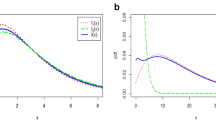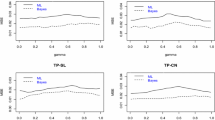Abstract
We here consider testing the hypothesis ofhomogeneity against the alternative of a two-component mixture of densities. The paper focuses on the asymptotic null distribution of 2 log λ n , where λ n is the likelihood ratio statistic. The main result, obtained by simulation, is that its limiting distribution appears pivotal (in the sense of constant percentiles over the unknown parameter), but model specific (differs if the model is changed from Poisson to normal, say), and is not at all well approximated by the conventional χ 2(2) -distribution obtained by counting parameters. In Section 3, the binomial with sample size parameter 2 is considered. Via a simple geometric characterization the case for which the likelihood ratio is 1 can easily be identified and the corresponding probability is found. Closed form expressions for the likelihood ratio λ n are possible and the asymptotic distribution of 2 log λ n is shown to be the mixture giving equal weights to the one point distribution with all its mass equal to zero and the χ2-distribution with 1 degree of freedom. A similar result is reached in Section 4 for the Poisson with a small parameter value (θ≤0.1), although the geometric characterization is different. In Section 5 we consider the Poisson case in full generality. There is still a positive asymptotic probability that the likelihood ratio is 1. The upper precentiles of the null distribution of 2 log λ n are found by simulation for various populations and shown to be nearly independent of the population parameter, and approximately equal to the (1–2α)100 percentiles of χ 2(1) . In Sections 6 and 7, we close with a study of two continuous densities, theexponential and thenormal with known variance. In these models the asymptotic distribution of 2 log λ n is pivotal. Selected (1−α) 100 percentiles are presented and shown to differ between the two models.
Similar content being viewed by others
References
Agha, M. and Ibrahim, M. T. (1984). Maximum likelihood estimation of mixtures of distributions,J. Roy. Statist. Soc. Ser. C,33, 327–332.
Böhning, D. (1982). Convergence of Simar's algorithm for finding the maximum likelihood estimate of a compound Poisson process,Ann. Statist.,10, 1006–1008.
Böhning, D. (1989). Likelihood inference for mixtures: geometrical and other constructions of monotone step-length algorithms,Biometrika,76, 375–383.
Böhning, D. and Hoffmann, K.-H. (1982). Numerical techniques for estimating probabilities,J. Statist. Comput. Simulation,14, 283–293.
Böhning, D., Schlattmann, P. and Lindsay, B. G. (1992). Computer assisted analysis of mixtures (C.A.MAN): statistical algorithms,Biometrics,48, 283–303.
Cox, D. R. and Hinkley, D. V. (1974).Theoretical Statistics, Chapman and Hall, London.
Dempster, A. P., Laird, N. M. and Rubin, D. B. (1977). Maximum likelihood estimation from incomplete data via the EM algorithm (with discussion),J. Roy. Statist. Soc. Ser. B,39, 1–38.
Gediga, G. and Holling, H. (1988). On the convergence of the EM algorithm including different methods of Aitken acceleration for finite mixture models,Proceedings of the COMPSTAT Congress, Short Communications and Posters, 31–32.
Gibbons, R. D., Clark, D. C. and Fawcett, J. (1990). A statistical method for evaluating suicide clusters and implementing cluster surveillance,American Journal of Epidemiology,132, 183–191.
Goffinet, B., Loisel, P. and Laurent, B. (1992). Testing in normal mixture models when the proportions are known,Biometrika,79, 842–846.
Laird, N., Lange, N. and Stram, D. (1985). Maximum likelihood computation with repeated measures: application of the EM algorithm,Proceedings of the Statistical Computing Section, 34–44.
Lesperance, M. and Kalbfleisch, J. D. (1992). An algorithm for computing the nonparametric MLE of a mixing distribution,J. Amer. Statist. Assoc.,87, 120–126.
Lindsay, B. G. (1983). The geometry of mixture likelihoods: a general theory,Ann. Statist.,11, 86–94.
Louis, T. A. (1982). Finding the observed information matrix when using the EM algorithm,J. Roy. Statist. Soc. Ser. B,44, 226–233.
McLachlan, G. J. and Basford, K. E. (1988).Mixture Models; Inference and Applications to Clustering, Marcel Dekker, New York.
Meilijson, I. (1989). A fast improvement to the EM algorithm in its own terms,J. Roy. Statist. Soc. Ser. B,51, 127–138.
Mendell, N. R., Thode, H. C. and Finch, S. J. (1991). The likelihood ratio test for the two-component normal mixture problem: power and sample size analysis,Biometrics,47, 1143–1148.
Self, S. G. and Liang, K.-Y. (1987). Asymptotic properties of maximum likelihood estimators and likelihood ratio tests under nonstandard conditions,J. Amer. Statist. Assoc.,82, 605–610.
Thode, H. C., Finch, S. J. and Mendell, N. R. (1988). Simulated percentage points for the null distribution of the likelihood ratio test,Biometrics,44, 1195–1201.
Titterington, D. M., Smith, A. F. M. and Makov, W. E. (1985).Statistical Analysis of Finite Mixture Distributions, Wiley, New York.
Wu, C. F. (1983). On the convergence properties of the EM algorithm,Ann. Statist.,11, 95–103.
Author information
Authors and Affiliations
About this article
Cite this article
Böhning, D., Dietz, E., Schaub, R. et al. The distribution of the likelihood ratio for mixtures of densities from the one-parameter exponential family. Ann Inst Stat Math 46, 373–388 (1994). https://doi.org/10.1007/BF01720593
Received:
Revised:
Issue Date:
DOI: https://doi.org/10.1007/BF01720593




